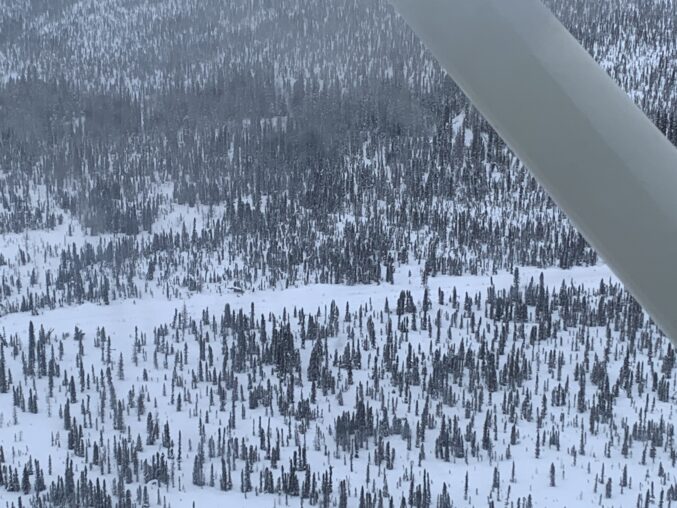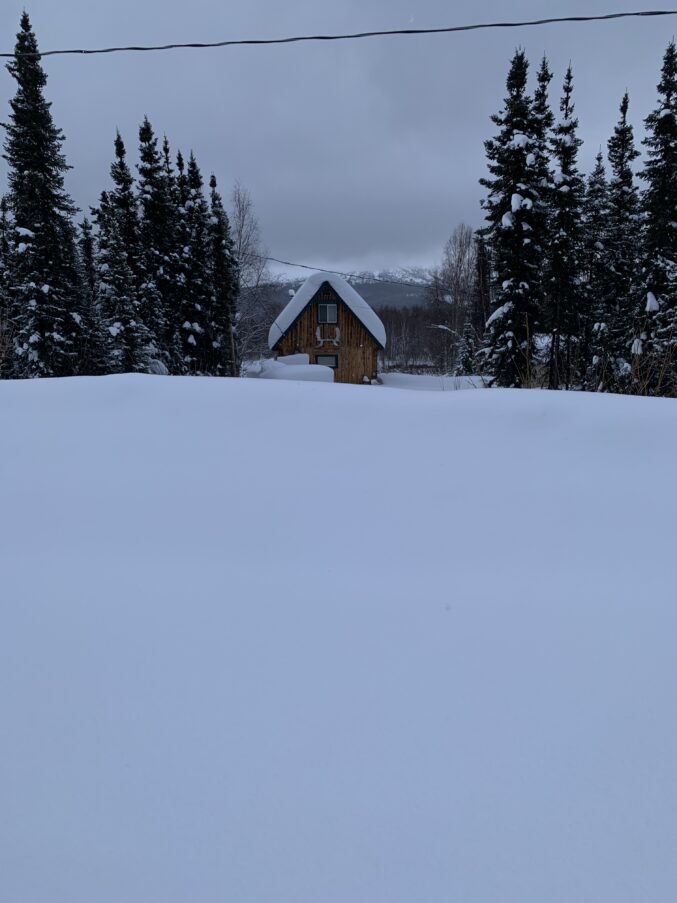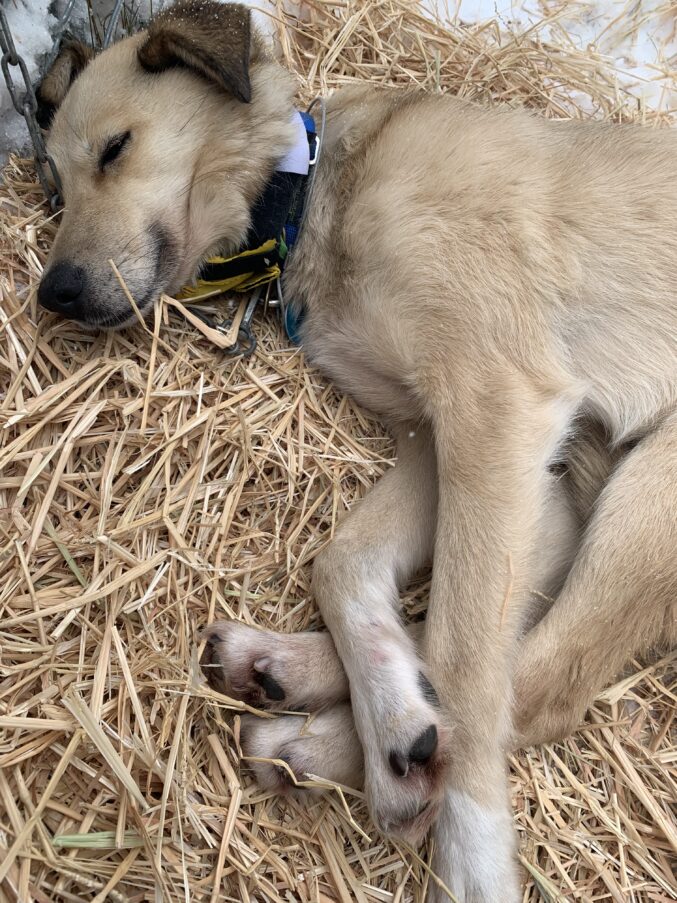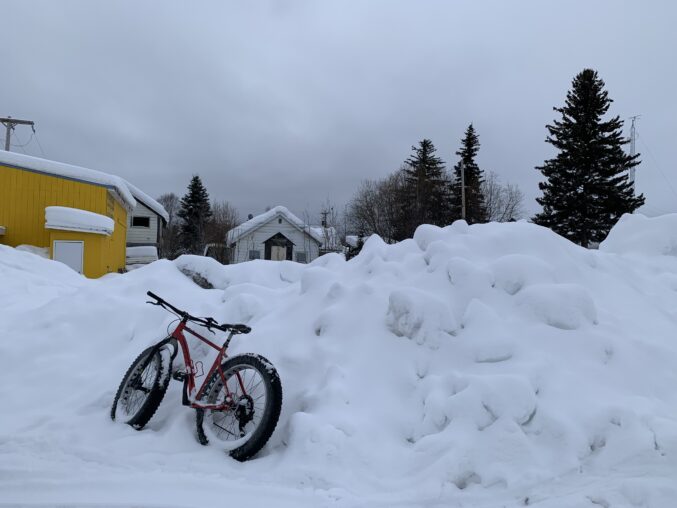This morning I was sitting in the McGrath roadhouse having breakfast with new friends, Iditarod Trail volunteers. Suddenly a representative from Logs, the logistics arm that gets people where they need to be, rushed over. “I found you!” the agent said. “Do you want to go on a scenic flight to Ophir? It would just be to see the trail from the air.” Of course I said yes and grabbed my coat, leaving a half-finished cup of coffee on the table.

The Iditarod Trail from the air near Ophir. Photo: K. Newmyer
The trip was amazing! Seeing the Iditarod trail from above helped me get a completely new perspective on the race, one I hadn’t anticipated. Then we landed and I was in Takotna, home of the pies! I had been planning to visit Takotna, so I was happy with the new change of plans. The pilot said someone would come get me with a snowmachine, so I could start walking. I ended up seeing no one and walking the whole distance, about a mile in heavy boots and gear. It was hard but glorious! The spaces in Alaska between structures and activity are quiet, silent, with no movement. Mountains peeped from under low clouds, and snowflakes drifted down on the trees as I walked. I saw abandoned train cars buried in snow, and tracks of all kinds on the path.

A cabin near Takotna. Photo: K. Newmyer
I checked into comms as soon as I found it, but not before meeting two of the nicest ladies who worked at the school (10 students K-12) and literally bumping into musher Gabe Dunham as she was headed into the cabin to get some food. We chatted for a few minutes and I snapped some photos of the dogs resting peacefully on their straw. After I began a tour of the town, Bev from comms came running to get me, saying my flight back to McGrath was arriving in 15 minutes. So much for having a slice of pie! But I got a sense of how the community helps the volunteers get the checkpoint ready and a peek at resting dogs.
I met Wendy and a new friend, Beth, for lunch, and afterward headed out to find the returned dogs, awaiting their flight back to Anchorage. (If you aren’t sure, returned dogs are left at a checkpoint for sore muscles or other reasons and given a safe trip back to their homes.) One of the vets gave me a tour. I got to rest a few minutes with beautiful pups sporting the lovely blankets school kids everywhere had made them. I got a few nose boops and petted quite a few furry heads.

A dog sweetly rests at the McGrath checkpoint. Photo: K. Newmyer
What does all of this have to do education? As I’ve written about many times, the Iditarod teaches many powerful character lessons that students can benefit from. But in this post I want to encourage teachers to benefit from two powerful lessons of the Iditarod: the ability to say yes when you’re unsure, and to change course quickly when you need to.
Mushers are making their way through tough trail conditions right now, including the relatively snowless Farewell Burn. Racers are having to switch and redo the schedules they planned for. The lovely little snowflakes falling on me during my walk made for soft, mushy trail conditions. The temperature was not ideal for the dogs—it was way too warm. Both of these factors caused mushers to have to slow down and rethink the next section of race strategy as they head toward the Yukon River.
Teachers, we know what it means to pivot. A lesson goes wrong or falls flat, kids didn’t learn what you thought you taught them after all, or a student has a sad event happen in their lives and can’t function that day. A fire drill interrupts your great learning activity, a behavior issue erupts, and so on.
But I invite you to rethink the word “pivot”—in fact, let’s get rid of it altogether. Instead of pivot, let’s pirouette, twirl, bank sharply—or take a hard gee to the right. Not every day is going to be perfect in the classroom, and in fact, very few are. Teachers, we got this. Race conditions change. Someone grabs you and you have to make a split decision to say yes or no. A hard struggle ends up being a deeply meaningful experience.

A scene near the roadhouse. Photo: K. Newmyer
The Iditarod teaches us year after year that while the race is iconic, it’s never the same. Sleds break, favorite dogs become picky eaters, weather changes. You, as a teacher, have agency to about-face into a new, better reality. This requires a little bit of self reflection and a whole lot of fresh clean dog booties.
Find the places in your teaching practice where the need to make a U-turn is glaringly clear. Is it how you approach a difficult personality? Do you need to be more intentional in your planning? Is it your own-self doubt? There’s no shame in realizing you were on the wrong trail in your lesson or classroom procedures. The trick is to determine the correct one, get those dogs untangled, and mush on. I challenge you to say yes, if at all reasonable, to the next thing you’re asked to do. Then get after it like sled dogs on the move.
If I hadn’t said yes to the flight, I might not have had to walk uphill both ways to the checkpoint. But I would also have missed out on the scenic view, the aerial view of the trail, and my pilot’s excellent tour of the old mining area. If I hadn’t deviated from my plan of having a nap after little sleep the night before, I would not have had some quality time with sweet dogs away from the bustle. So take a chance on that field trip or crazy student idea. Say yes to a new responsibility. Find out if you have what it takes to move up in your career. Iditarod sled dogs will be the first to tell you that though the journey has its ups and downs and plenty of gee and haw—it’s the one you’re supposed to be having.
Email me at emailthteacher@iditarod.com.


